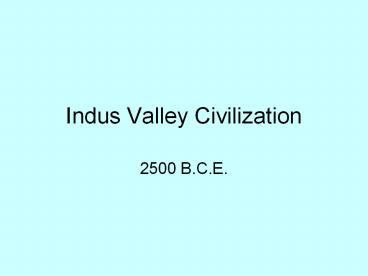Indus Valley Civilization - PowerPoint PPT Presentation
Title:
Indus Valley Civilization
Description:
Indus Valley Civilization 2500 B.C.E. * * The Aryans did not use writing, but they composed poems and songs. They preserved extensive collections of religious and ... – PowerPoint PPT presentation
Number of Views:480
Avg rating:3.0/5.0
Title: Indus Valley Civilization
1
Indus Valley Civilization
- 2500 B.C.E.
2
Roots of Indus Valley Civilization
- Earliest civilizations in Indus Valley was
discovered in 1856 by a railroad crew. - Harappa
- Mohenjo-Dara or Hill of the Dead
- Both cities shared urban design and architectural
features.
3
- Page 92
4
Roots of Indus Valley Civilization
- Roots of Indus Valley began as early as 7000
B.C.E. - Herders who migrated to the valley
- Farm rich soil
- They began trading by boat along the Indus down
into the Arabian Sea, into the Persian Gulf, and
up the Tigris and Euphrates into Mesopotamia.
5
The Artifacts Crafts and the Arts
- Crafts of the Indus valley included pottery
making, dyeing, metal working in bronze, and bead
making.
6
Mohenjo-Daro and Harappa
- To the north is a citadel or raised area.
- In Mohenjo-Daro, the citadel is built on an
architectural platform about 45 feet above the
plain. - On the summit was a huge communal bath.
- Next to the large bath was a huge open spacea
granary where food was stored from possible
floods. - Fortified walls mark the southeast corner.
7
(No Transcript)
8
Mohenjo-Daro and Harappa
- The lower city was laid out in a gridiron with
the main streets about 45 feet wide. - Private houses, almost every one with its own
well, bathing space, and toilet consisting of a
brick seat over a drainage area. - Brick-lined drains flushed by water carried
liquid and solid waste to sumps, where it was
carted away, probably to fertilize nearby fields.
9
Mohenjo-Daro and Harappa
- The town plan was regular.
- Even fire-baked bricks were uniform in size and
shape. - The regularity of plan and construction suggests
a government with organization and bureaucratic
capacity. - No monumental architecture clearly marks the
presence of a palace or temple. - There is little sign of social stratification in
the plan or buildings.
10
Indus Valley Burial Sites
- Heads pointing to the north
- Some grave goods, such as pots of food and water,
small amounts of jewelry, simple mirrors, and
some cosmetics. - Not extravagant like royal burials of Egypt or
even of Mesopotamia.
11
Aryan Influence on Harappan Society
- Aryan migrations took place over several
centuries. - By the time Aryans entered India, internal
problems had already brought Harappan society to
the point of collapse. - Aryans intermarried with existing people
blending cultures
12
The Vedic Age 1500 to 500 B.C.E.
- Periods of competition over land and resources
- Aryan government consisted of a raja who ruled a
chiefdom
13
Caste System
14
Aryan Society
- Aryan Society had a strong patriarchal social
order at the time of their migration into India. - All priests, warriors and tribal chiefs were men.
- Women influenced affairs within their families
but had no public authority. - Women rarely learned the Vedas and were denied
formal education. - Sati, the practice of a wife sacrificing herself
on her husbands funeral pyre, was considered
noble.
15
Aryan Religion
- The Vedas were collections of religious and
literary poems and songs transmitted orally. - There were four parts.
- The most important part was the Rig Veda, a
collection of 1,028 hymns addressed to the Aryan
gods. - Aryan priests compiled the Rig Veda between 1400
and 900 B.C.E. - It wasnt put into writing until about 600 B.C.E.
16
Religion in Vedic Age
- The Rig Veda sheds light on religious practices.
- The chief deity was Indra, a war god, who was
partial to fighting and drink. - Varuna was a god who presided over the sky from
his heavenly palace. He oversaw behavior of
morals and preserved order. - Cattle, sheep, goats, and horses from Aryan herds
were sacrificed to gain divine support, large
families, long life, and abundant herds. - Belief in reincarnation appears during the Vedic
Age
17
The Upanishads
- Appeared late in Vedic Age, around 800 to 400
B.C.E. - Upanishad means sitting in front of and refers
to practice of disciples gathering before a sage
for discussion of religious issues. - The Upanishads were dialogues that explored the
Vedas.
18
The Upanishads
- Each person is part of a large, cosmic order and
forms a small part of a universal soul known as
Brahman. - Brahman is an eternal, unchanging foundation for
all things. - Individual souls were born into physical world
many times. - Their souls were most often humans but sometimes
animals, and even occasionally plants. - The highest goal of the individual soul is to
escape the cycle of birth and rebirth to enter
into permanent union with Brahmin.
19
Doctrines of the Upanishads
- Samsara Upon death, individuals go temporarily
to the World of the Fathers and then return to
earth in a new form. - Karma a man of good acts will become good, a
man of bad acts, bad. He becomes pure by pure
deeds, bad by bad deeds. - Suffering A certain amount of pain and
suffering is inevitable in human existence. - Moksha is a deep endless sleep that comes with
permanent liberation from physical incarnation. - Brahmin You can achieve Brahmin through
meditation and asceticism, leading extremely
simple lives and denying all pleasure.
20
Religion and Vedic Age
- Modern historians have often interpreted the
Upanishads as a way to justify social
inequalities imposed by the Caste System. - The doctrines of Samsara and karma have
reinforced the Vedic social order.































